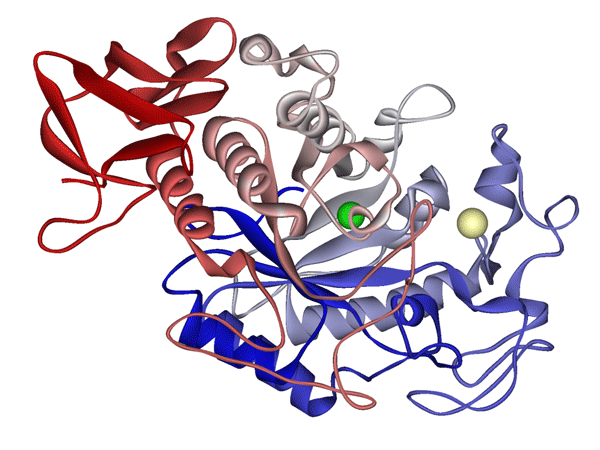Classification of enzyme:
Classification of the enzyme is very important to study Enzymes and their catalyzation activity on any chemical reaction. The Enzymes are classified according to the reaction they catalyze. The classification is shown below:
Oxidoreductase:
Oxidoreductase is an enzyme that catalyzes electrons being transferred from one molecule to another. The transfer of electrons means the transfer of the hydride of a hydrogen atom. That means this type of enzyme catalyzes the oxidation-reduction(redox) reaction.
Reaction:

Here, the enzyme (Lactate dehydrogenase) catalyzed the reaction where the two hydrogens are transferred to NAD+.
Transferases:
Transferases are enzymes that catalyze the transfer of a functional group from a donor molecule to an acceptor molecule. Here Group transfer reactions occur.
Example:
In the above reaction, the NH3+ functional group is transferred to alpha keto-glutarate reactant at the same time the (>C=O) ketone functional group is also transferred to the Alanine reactant.
Hydrolases:
Hydrolases are a class of enzymes that catalyze the hydrolysis of a chemical bond.
An enzyme catalyzing the following reaction, for instance, is hydrolase:
A–B + H2O → A–OH + B–H.
In the above symbolic reaction, the AB molecule (a subtract) reacts with water. If this particular reaction is catalyzed by an enzyme, then the enzyme is the hydrolase enzyme.
Lyase:
Lyase is an enzyme that catalyzes the breaking (an “elimination” reaction) of various chemical bonds by means other than hydrolysis and oxidation, often forming a new double bond or a new ring structure.
Example:
In this reaction, it eliminates CO2 from pyruvate as well as breaks bonds. The pyruvate dehydrogenase enzyme catalyzes this reaction. On the other hand, another reaction in the above example, there are hydrogen gets in the acetaldehyde structure by breaking bonds of NADH+H+. The alcohol dehydrogenase catalyzes this one. So pyruvate dehydrogenase and alcohol dehydrogenase enzymes are Lyse enzymes.
Ligase:
Ligase is an enzyme that can catalyze the joining of two large molecules by forming a new chemical bond (Formation of C─C, C─S, C─O, and C─N bonds by condensation reactions coupled to ATP cleavage).
Example:
In this example, the bicarbonate and pyruvate molecules are joined together to form oxalacetate. The pyruvate carboxylase enzyme catalyzes this reaction, Therefore, this enzyme is a Ligase enzyme.
Isomerases:
Isomerases are enzymes catalyzing a molecule’s isomerization. In other words, they enable particular functional groups to be transferred
Example:
Notice carefully, the structure of the above molecule changes through the reaction. That means there is an isomer is forming. The phosphoglucose isomerase enzyme catalyzes this isomerization reaction. So it is an Isomerases enzyme.
Enzymes are categorized by the sort of reaction that they catalyze. The classification of the enzyme at a glance-
Classification of Enzymes |
|||
| Class | Reaction catalyzed | Example | Reactions |
| Oxidoreductases | Oxidation-reduction | Lactate dehydrogenase |  |
| Transferases | Transfer groups of atoms | Alanine transferase |  |
| Hydrolases | Hydrolysis | Sucrase |  |
| Lyases | Add atoms/remove atom to/from a double bond | Pyruvate decarboxylate |  |
| Isomerases | Rearrange atoms | Maleate isomerase |  |
| Ligases | Use ATP to mix molecules together | Acetyl-Co A synthetase |  |
Follow Us On Facebook, Twitter, Linkdin, and Youtube.
please share this article with your friends.
Read more about-


Leave a Reply